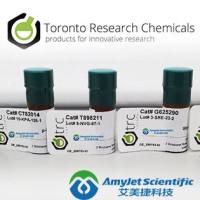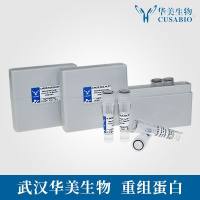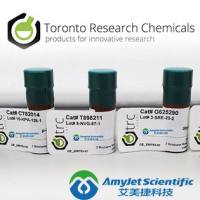Bisulfite Modification for Analysis of DNA Methylation
互联网
- Abstract
- Table of Contents
- Materials
- Figures
- Literature Cited
Abstract
Bisulfite is known to deaminate cytosine in nucleic acids, while 5?methylcytosine resists this bisulfite action. For this reason, bisulfite treatment has been used for detecting 5?methylcytosine in DNA, a minor component of eukaryotic DNA, presently recognized as playing an important role in the control of gene function. This procedure, called bisulfite genomic sequencing, is a principal method for the analysis of DNA methylation in various biological phenomena, including human diseases such as cancer. This unit describes an efficient procedure utilizing a newly developed high?concentration bisulfite solution. Protocols for this methodology are supplemented with discussions focused on chemical aspects of the bisulfite treatment. Curr. Protoc. Nucleic Acid Chem. 33:6.10.1?6.10.15. © 2008 by John Wiley & Sons, Inc.
Keywords: high?concentration bisulfite; 5?methylcytosine; cytosine deamination; bisulfite genomic sequencing; quantification of bisulfite
Table of Contents
- Introduction
- Basic Protocol 1: Preparation of Bisulfite Solution
- Basic Protocol 2: Bisulfite‐Mediated Deamination of Cytosine and 5‐Methylcytosine
- Basic Protocol 3: Bisulfite Modification of Bulk DNA
- Basic Protocol 4: Bisulfite Treatment for Genomic Sequencing of Methylated and Unmethylated DNA
- Commentary
- Literature Cited
- Figures
- Tables
Materials
Basic Protocol 1: Preparation of Bisulfite Solution
Materials
Basic Protocol 2: Bisulfite‐Mediated Deamination of Cytosine and 5‐Methylcytosine
Materials
Basic Protocol 3: Bisulfite Modification of Bulk DNA
Materials
Basic Protocol 4: Bisulfite Treatment for Genomic Sequencing of Methylated and Unmethylated DNA
Materials
|
Figures
-
Figure 6.10.1 Determination of 5‐methylcytosine (Cm ) in DNA. Comparison of unmethylated and methylated genes by bisulfite modification. Bisulfite treatment converts C to U, which is then replaced with T by DNA polymerase during PCR amplification. Cm is inert to bisulfite treatment, and is thus maintained as C during amplification. Sequencing reveals the sites where C was replaced with T. Reproduced from Hayatsu () with permission from the Japanese Environmental Mutagen Society. View Image -
Figure 6.10.2 Deamination of dC and 5‐methyl‐dC at pH 5.4. Circles: dC with 9 M bisulfite at 70°C. Diamonds: dC with 5.3 M sodium bisulfite at 70°C. Triangles: 5‐Me‐dC with 9 M bisulfite at 90°C. Squares: 5‐Me‐dC with 9 M bisulfite at 70°C. Reproduced from Hayatsu et al. () with permission from The Japan Academy. View Image -
Figure 6.10.3 Bulk treatment of DNA by bisulfite. (A ) Untreated DNA and (B ) DNA treated with 9 M bisulfite for 10 min at 90°C was digested and the nucleosides were analyzed by HPLC, and monitored by absorbance at 260 nm. Elution times for 2′‐dC, 2′‐dU, 5‐Me‐2′‐dC, 2′‐dG, T, and 2′‐dA are 19, 22, 25, 26, 28, and 32 min, respectively. Reproduced from Hayatsu et al. () with permission from The Japan Academy. View Image -
Figure 6.10.4 Conversion of cytosine to uracil. Reaction 1: The reversible addition of bisulfite across the 5,6‐double bond of cytosine is a rapid process that results in an equilibrium between C and C‐SO3 − . In acidic conditions, the equilibrium is shifted to the C‐SO3 − side. The lower the temperature, the more C‐SO3 − is formed. Reaction 2: Deamination of C‐SO3 − to U‐SO3 − is the rate‐determining step in the conversion from C to U. The effect of pH is remarkable; the optimum is pH 5 to 6. An unanticipated but important fact is that the velocity of reaction 2 increases in proportion to the bisulfite concentration. Reaction 3: Conversion of U‐SO3 − to U is an equilibrium process in the presence of bisulfite. In practice, however, after removal or dilution of bisulfite in the reaction mixture, U‐SO3 − is treated with an alkali to recover the 5,6‐double bond. With 5‐methylcytosine as reactant, both reactions 1 and 2 are much less efficient. Reproduced from Hayatsu () with permission from the Japanese Environmental Mutagen Society. View Image -
Figure 6.10.5 pH‐Rate profile for deamination of 2′‐deoxycytidine in 7 M bisulfite. Reaction extents at 60°C and 5 min are plotted. Reproduced from Hayatsu et al.(2004) with permission from The Japan Academy. View Image -
Figure 6.10.6 Relationship between the deamination rate and bisulfite concentration at pH 5.0 and 5.8. Solid lines: Calculated on the assumption that bisulfite participates in both reaction 1 and reaction 2 shown in Fig. . Dotted lines: Calculated on the assumption that bisulfite participates only in reaction 1. Reproduced from Hayatsu () with permission from the Japanese Environmental Mutagen Society. View Image -
Figure 6.10.7 Two diastereomeric thymine‐bisulfite adducts. Reproduced from Hayatsu () with permission from the Japanese Environmental Mutagen Society. View Image -
Figure 6.10.8 Efficiency of the conversion of cytosine to uracil by treatment with 9 M bisulfite (A ) at 90°C and (B ) at 70°C. Open circles indicate the ratio of conversion of nonmethylated cytosine to uracil per plasmid clone (e.g., the value 0.9 indicates 72 cytosine residues out of 80). Closed circles indicate the ratio of converted 5‐methylcytosine in the entire population of plasmid clones that were sequenced (e.g., the value 0.02 indicates a total of 1 out of 50 5‐methylcytosines). Similar experiments were performed again using independently treated samples and a similar efficiency of conversion was confirmed (data not shown). Reproduced from Shiraishi and Hayatsu () with permission from Oxford University Press. View Image
Videos
Literature Cited
| Literature Cited | |
| Baly, E.C.C. and Bailey, R.A. 1922. Equilibrium in aqueous solutions of the alkali metal bisulfites. J. Chem. Soc. 121:1813‐1821. | |
| Blin, N. and Stafford, D.W. 1976. A general method for isolation of high molecular weight DNA from eukaryotes. Nucleic Acids Res. 3:2303‐2308. | |
| Cashmore, A.R. and Petersen, G.B. 1969. The degradation of DNA by hydrazine: A critical study of the suitability of the reaction for the quantitative determination of purine nucleotide sequences. Biochim. Biophys. Acta 174:591‐603. | |
| Church, G.M. and Gilbert, W. 1984. Genomic sequencing. Proc. Natl. Acad. Sci. U.S.A. 81:1991‐1995. | |
| Clark, S.J., Stathem, A., Stirzaker, C., Molloy, P.L., and Frommer, M. 2006. DNA methylation: Bisulfite modification and analysis. Nature Protocols 1:2353‐2364. | |
| Eads, C.A. and Laird, P.W. 2002. DNA methylation protocols. In Methods in Molecular Biology (K.I. Millis and B.H. Ramsahoye, eds.) Vol. 200. pp. 71‐85. Humana Press, Totowa, New Jersey. | |
| Fritzsche, E., Hayatsu, H., Igloi, G., Iida, S., and Kössel, H. 1987. The use of permanganate as a sequencing reagent for identification of 5‐methlcytosine residues in DNA. Nucleic Acids Res. 15:5517‐5528. | |
| Frommer, M., McDonald, M.E., Millar, D.S., Collis, C.M., Watt, F., Grigg, G.W., Molloy, P.L., and Paul, C.L. 1992. A genomic sequencing protocol that yields a positive display of 5‐methylcytosine residues in individual DNA strands. Proc. Natl. Acad. Sci. U.S.A. 80:1579‐1583. | |
| Hayatsu, H. 1976. Bisulfite modification of nucleic acids and their constituents. Prog. Nucleic Acid Res. Mol. Biol. 16:75‐124. | |
| Hayatsu, H. 2006. Bisulfite modification of cytosine and 5‐methylcytosine as used in epigenetic studies. Genes Environment 28:1‐8. | |
| Hayatsu, H. and Miller, R.C. 1972. The cleavage of DNA by the oxygen‐dependent reaction of bisulfite. Biochem. Biophys. Res. Commun. 46:120‐124. | |
| Hayatsu, H. and Shiragami, M. 1979. Reaction of bisulfite with 5‐hydroxymethyl group in pyrimidines and in phage DNAs. Biochemistry 18:632‐637. | |
| Hayatsu, H., Wataya, Y., and Kai, K. 1970a. The addition of sodium bisulfite to uracil and to cytosine. J. Am. Chem. Soc. 92:724‐726. | |
| Hayatsu, H., Wataya, Y., Kai, K., and Iida, S. 1970b. Reaction of sodium bisulfite with uracil, cytosine and their derivatives. Biochemistry 9:2858‐2865. | |
| Hayatsu, H., Negishi, K., and Shiraishi, M. 2004. DNA methylation analysis: Speedup of bisulfite‐mediated deamination of cytosine in the genomic sequencing procedure. Proc. Jpn. Acad. Ser. B Phys. Biol. Sci. 80:189‐194. | |
| Iida, S. and Hayatsu, H. 1971. The permanganate oxidation of deoxyribonucleic acids. Biochim. Biophys. Acta 240:370‐375. | |
| Itadani, A., Shiragami, M., Kawada, R., Wataya, Y., and Hayatsu, H. 1981. Sulfite‐ion‐catalyzed reversion of 5,6‐dihydrothymine‐6‐sulfonate to thymine. A general‐base‐catalyzed reaction. J. Chem. Soc., Perkin Trans. I 1287‐1292. | |
| Mueller, P.R. and Wold, B. 1989. In vivo footprinting of a muscle specific enhancer by ligation‐mediated PCR. Science 246:780‐786. | |
| Munson, K., Clark, J., Lamparska‐Kupsik, K., and Smith, S.S. 2007. Recovery of bisulfite‐converted genomic sequences in the methylation‐sensitive QPCR. Nucleic Acids Res. 35:2893‐2903. | |
| Ohmori, H., Tomizawa, J., and Maxam, A.M. 1978. Detection of 5‐methylcytosine in DNA sequences. Nucleic Acids Res. 5:1479‐1485. | |
| Pfeifer, G.P., Steigerwald, S.D., Mueller, P.R., Wold, B., and Riggs, A.D. 1989. Genomic sequencing and methylation analysis by ligation‐mediated PCR. Science 246:810‐813. | |
| Shapiro, R., Servis, R.E., and Welcher, M. 1970. Reactions of uracil and cytosine derivatives with sodium bisulfite. A specific deamination method. J. Am. Chem. Soc. 92:422‐424. | |
| Shapiro, R., Braverman, B., Louis, J.B., and Servis, R.E. 1973. Nucleic acid reactivity and conformation. J. Biol. Chem. 248:4060‐4064. | |
| Shapiro, R., DiFate, V., and Welcher, M. 1974. Deamination of cytosine derivatives by bisulfite. Mechanism of the reaction. J. Am. Chem. Soc. 96:906‐912. | |
| Shiragami, M., Iida, S., Kudo, I., and Hayatsu, H. 1975. Formation of diastereomers of 5,6‐dihydrothymine‐6‐sulfonate by deamination of 5‐methylcytosine with bisulfite. Chem. Pharm. Bull. 23:3027‐3029. | |
| Shiraishi, M. and Hayatsu, H. 2004. High‐speed conversion of cytosine to uracil in bisulfite genomic sequencing analysis of DNA methylation. DNA Res. 11:409‐415. | |
| Shiraishi, M., Oates, A.J., and Sekiya, T. 2002. An overview of the analysis of DNA methylation in mammalian genomes. Biol. Chem. 383:893‐906. | |
| Sono, M., Wataya, Y., and Hayatsu, H. 1973. Role of bisulfite in the deamination and the hydrogen isotope exchange of cytidylic acid. J. Am. Chem. Soc. 95:4745‐4749. | |
| Temperli, A., Türler, H., Rüst, P., Danon, A., and Chargaff, E. 1964. Studies on the nucleotide arrangement on nucleic acids. IX. Selective degradation of pyrimidine deoxyribonucleotides. Biochim. Biophys. Acta 91:462‐476. |







